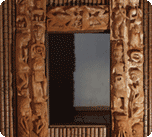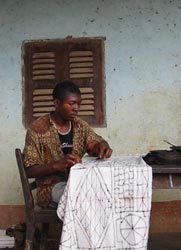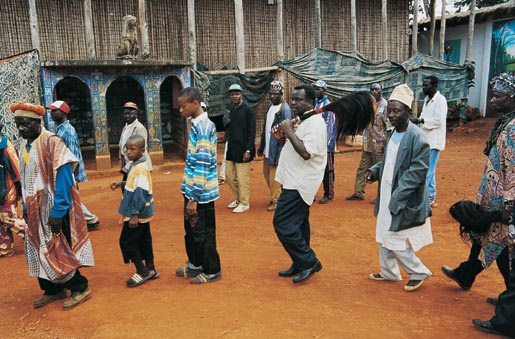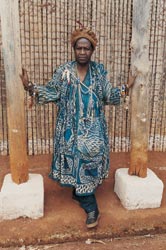
 |
|
| The Baham museum | |
| Permanent exhibition | |
| Information | |
Costumes and textile art
In daily life, during dances and ceremonies, the Baham wear a great variety of costumes and symbolic, cultural or prestigious head-dresses, made from different fabrics, of which the richest in meanings and most important is ndop ( dzedouop) or souo’ (dze souo’).

The dja'bum society in action
There are several kinds of ndop in the Grasssland and with the neighbouring peoples, which vary according to the local name, the dye, the type of cotton, the overstitching in raffia, the type and production of the designs. The use of ndop (and probably its decoration) in Baham is believed to date from at least the 18th century. Invaluable ancient specimens of costumes, makem, are preserved in the royal palace at Baham which were used in ritual ceremonies and which belonged to different periods but difficult to date. Through analysis, it is possible to observe the evolution of the technique of ndop , which has improved over time to reach its current and most elaborate form. Ndop or douop is made from cotton. It is made from narrow strips sewn edge to edge and decorated with characteristic white patterns on an indigo blue background. |
 |
|
Artist decorating ndop or douop |
|
The same decorative patterns (stylised animals, geometric shapes, moon, star, sun etc.) are found in basketwork, on wooden sculptures and in bead embroidery. To obtain this decoration, the artist sews very close stitched in raffia on the fabric, following the lines of the patterns that he has previously drawn out. The fabric will then be immersed into indigo to give it its blue background. Not even a drop of the dye must go through the seams, which will be removed when the fabric as dried. The white patterns of the decoration will then appear on the indigo blue background. The white fabric is obtained in the north of the country by spinning and weaving cotton, which is then transported to the Bamiléké country, in particular to Baham, the main centre of production of the fabric dze douop. The cloth is decorated then sent to its place of departure where it is dyed indigo blue and lastly it is taken back to Baham where specialists do the finishing work (cut-outs and edges). |
|
The notable wabo Dzuwa’, chief of la’kam, in a ndop costume |
The decoration of the ndop with patterns is a real book where the message written by the embroiderer can be read in the signs. The fabric has many uses. It is used to make costumes such as the makem for the king, notables and secret societies only. It is used as the shroud that the body of the fe u is wrapped in for burial. The place where funeral ceremonies of important figures are held are decorated with lengths of nd op. Ndop has a very special symbolic value.

Use of ndop fabric during a funeral ceremony
|
|
[ Top page ]
| Home | The four museums | The project | Baham museum | Bandjoun museum | Mankon museum | Babungo museum |
| baham@museumcam.org | Copyright 2005 C.O.E. | Powered by SYNUS |

















